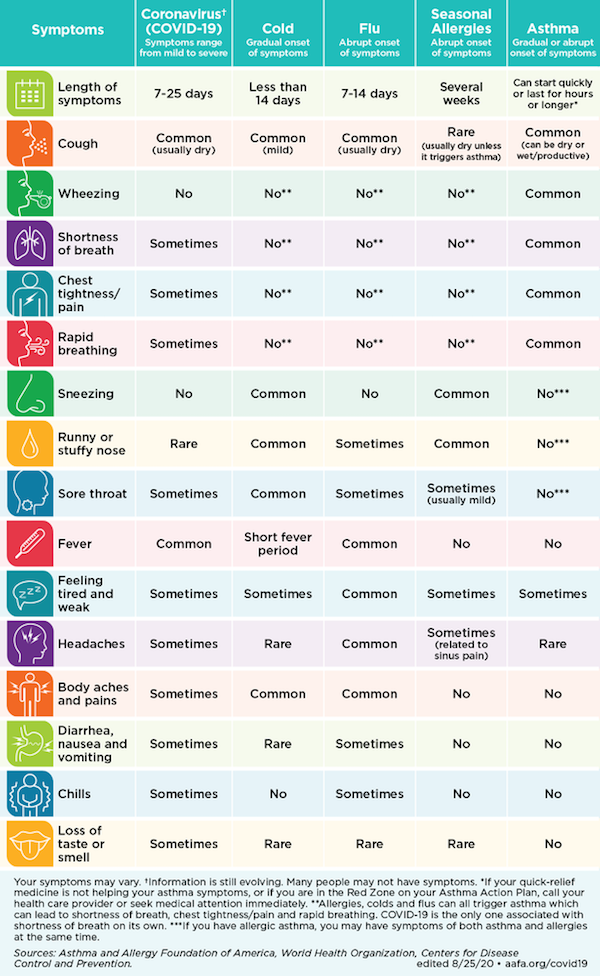Flu and COVID-19 are both contagious respiratory illnesses, but they are caused by different viruses. Here are a few notable differences between the two.
What is the difference between Influenza (Flu) and COVID-19?
Information Sourced From: Centers for Disease Control and Prevention
Influenza (Flu) and COVID-19 are both contagious respiratory illnesses, but they are caused by different viruses. COVID-19 is caused by infection with a new coronavirus (called SARS-CoV-2) and flu is caused by infection with influenza viruses. Because some of the symptoms of flu and COVID-19 are similar, it may be hard to tell the difference between them based on symptoms alone, and testing may be needed to help confirm a diagnosis. Flu and COVID-19 share many characteristics, but there are some key differences between the two.
While more is learned every day, there is still a lot that is unknown about COVID-19 and the virus that causes it.
How to Protect Yourself and Others from COVID-19
How to Protect Yourself and Others from the Flu
Signs and Symptoms
Information Sourced From: Centers for Disease Control and Prevention
According to the Centers for Disease Control and Prevention (CDC), both COVID-19 and flu can have varying degrees of signs and symptoms, ranging from no symptoms (asymptomatic) to severe symptoms. Common symptoms that COVID-19 and flu share include:
- Fever or feeling feverish/chills
- Cough
- Shortness of breath or difficulty breathing
- Fatigue (tiredness)
- Sore throat
- Runny or stuffy nose
- Muscle pain or body aches
- Headache
- Some people may have vomiting and diarrhea, though this is more common in children than adults
Differences
- Flu: Flu viruses can cause mild to severe illness.
- COVID-19: Other signs and symptoms of COVID-19, different from flu, may include change in or loss of taste or smell.
How long symptoms appear after exposure and infection?
Information Sourced From: Centers for Disease Control and Prevention
The CDC states that for both COVID-19 and the flu, one or more days can pass between a person becoming infected and when he or she starts to experience illness symptoms.
Differences
- Flu: Typically, a person develops symptoms anywhere from 1-4 days after infection.
- COVID-19: Typically, a person develops symptoms after five days, but symptoms can appear as early as two days after infection or as late as 14 days after infection, and the time range can vary.
How long can someone be infectious and spread the virus?
Information Sourced From: Centers for Disease Control and Prevention
For both COVID-19 and flu, it’s possible to spread the virus for at least one day before experiencing any symptoms. If a person has COVID-19, they may be contagious for a longer period of time than if they had flu.
Differences
- Flu: According to the CDC, most people with flu are contagious for about one day before they show symptoms. Older children and adults with flu appear to be most contagious during the initial 3-4 days of their illness but many remain contagious for about seven days. Infants and people with weakened immune systems can be contagious for even longer.
- COVID-19: *A patient with presumed or confirmed COVID-19 is considered to be infectious from 48 hours before their symptoms started until their isolation period ends. Asymptomatic patients with laboratory-confirmed COVID-19 infection are considered to be infectious from 48 hours before their test was taken until 10 days after their test was taken.
How it Spreads
Source: Centers for Disease Control and Prevention
Both COVID-19 and flu can spread from person-to-person, between people who are in close contact with one another (within about six feet). Both are spread mainly by droplets made when people with the illness (COVID-19 or flu) cough, sneeze or talk. These droplets can land in the mouths or noses of people who are nearby or possibly be inhaled into the lungs.
It may be possible that a person can get infected by physical human contact (e.g. shaking hands) or by touching a surface or object that has virus on it and then touching his or her own mouth, nose or possibly their eyes.
Both flu virus and the virus that causes COVID-19 may be spread to others by people before they begin showing symptoms, with very mild symptoms or who never developed symptoms (asymptomatic).
Differences
While COVID-19 and flu viruses are thought to spread in similar ways, COVID-19 is more contagious among certain populations and age groups than flu. Also, COVID-19 has been observed to have more superspreading events than flu. This means the virus that causes COVID-19 can quickly and easily spread to a lot of people and result in continuous spreading among people as time progresses.
People at High-Risk for Severe Illness
Information Sourced From: Centers for Disease Control and Prevention
Both COVID-19 and flu illness can result in severe illness and complications. Those at highest risk include:
- Older adults are twice as likely to have serious COVID-19 illness. This may be because immune systems change with age, making it harder to fight off diseases and infection. Older adults also are more likely to have underlying health conditions that make it harder to cope with and recover from illness.
- Individuals with certain underlying medical conditions
- COPD (chronic obstructive pulmonary disease)
- Immunocompromised state (weakened immune system) from solid organ transplant
- Obesity (body mass index [BMI] of 30 or higher)
- Serious heart conditions, such as heart failure, coronary artery disease, or cardiomyopathies
- Sickle cell disease
- Type 2 diabetes mellitus
Based on available information at this time, people with the following conditions might be at an increased risk for severe illness from COVID-19:
- Asthma (moderate-to-severe)
- Cerebrovascular disease (affects blood vessels and blood supply to the brain)
- Cystic fibrosis
- Hypertension or high blood pressure
- Immunocompromised state (weakened immune system) from blood or bone marrow transplant, immune deficiencies, HIV, use of corticosteroids, or use of other immune weakening medicines
- Neurologic conditions, such as dementia
- Liver disease
- Pregnancy
- Pulmonary fibrosis (having damaged or scarred lung tissues)
- Smoking
- Thalassemia (a type of blood disorder)
- Type 1 diabetes mellitus
Differences
- Flu: Young children are at higher risk of severe illness from flu.
- COVID-19: School-aged children infected with COVID-19 are at higher risk of Multisystem Inflammatory Syndrome in Children (MIS-C), a rare but severe complication of COVID-19.
Complications
Information Sourced From: Centers for Disease Control and Prevention
Both COVID-19 and flu can result in complications, including:
- Pneumonia
- Respiratory failure
- Acute respiratory distress syndrome (i.e. fluid in lungs)
- Sepsis
- Cardiac injury (e.g. heart attacks and stroke)
- Multiple-organ failure (respiratory failure, kidney failure, shock)
- Worsening of chronic medical conditions (involving the lungs, heart, nervous system or diabetes)
- Inflammation of the heart, brain or muscle tissues
- Secondary bacterial infections (i.e. infections that occur in people who have already been infected with flu or COVID-19)
Differences
- Flu: Most people who get flu will recover in a few days to less than two weeks, but some people will develop complications, some of these complications are listed above.
- COVID-19: Additional complications associated with COVID-19 can include:
- Blood clots in the veins and arteries of the lungs, heart, legs or brain
- Multisystem Inflammatory Syndrome in Children (MIS-C)
- COVID-19 emergency warning signs:
- Trouble breathing
- Persistent pain or pressure in the chest
- New confusion
- Inability to wake or stay awake
- Bluish lips or face
Approved Treatments
Information Sourced From: Centers for Disease Control and Prevention
People at high-risk of complications or who have been hospitalized for COVID-19 or flu should receive supportive medical care to help relieve symptoms and complications.
Differences
- Flu: Prescription influenza antiviral drugs are FDA-approved to treat flu. People who are hospitalized with flu or at high-risk of flu complications with flu symptoms are recommended to be treated with antiviral drugs as soon as possible.
- COVID-19: The National Institutes of Health (NIH) has developed guidance on treatment of COVID-19 which will be regularly updated as new evidence on treatment options emerges. While remdesivir is an antiviral agent that is being explored as a treatment for COVID-19 and is available under an Emergency Use Authorization (EUA), there are currently no drugs or other therapeutics approved by the Food and Drug Administration (FDA) to prevent or treat COVID-19. Studies are in progress to learn more.
What to Do If You Are Sick with COVID-19
Information Sourced From: Centers for Disease Control and Prevention
Vaccines for COVID-19 and flu must be approved or authorized for use by the FDA.
Differences
- Flu: There are multiple FDA-licensed influenza vaccines produced annually to protect against the 3-4 flu viruses that scientists anticipate each year.
- COVID-19: When a vaccine is approved and ready, distribution will be phased across populations. The only prioritization that is approved by the ACIP is for Phase 1a: healthcare personnel and long-term care facility residents. Phase 1b and 1c are proposed and still need to go through the approval process. Learn more





